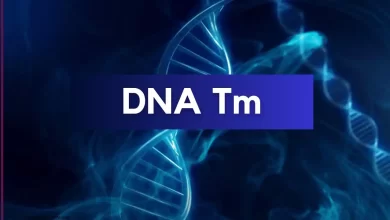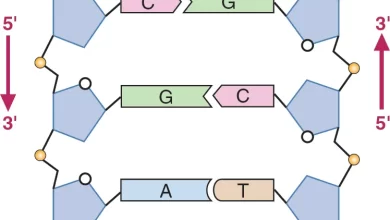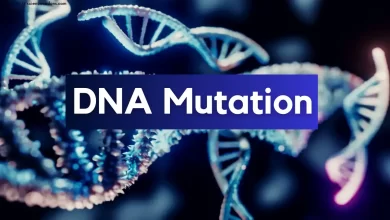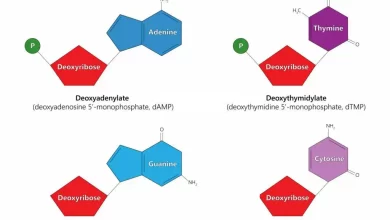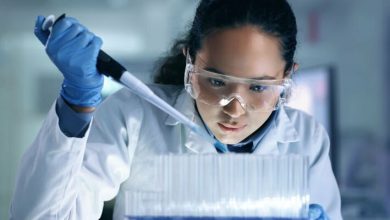DNA replication is a semi-conservative process, where half of the newly synthesized strands (daughters) are derived from the original strands (mothers). The confirmation of semi-conservative replication came through a series of experiments and investigations conducted over several years, providing solid evidence for the process of DNA replication.
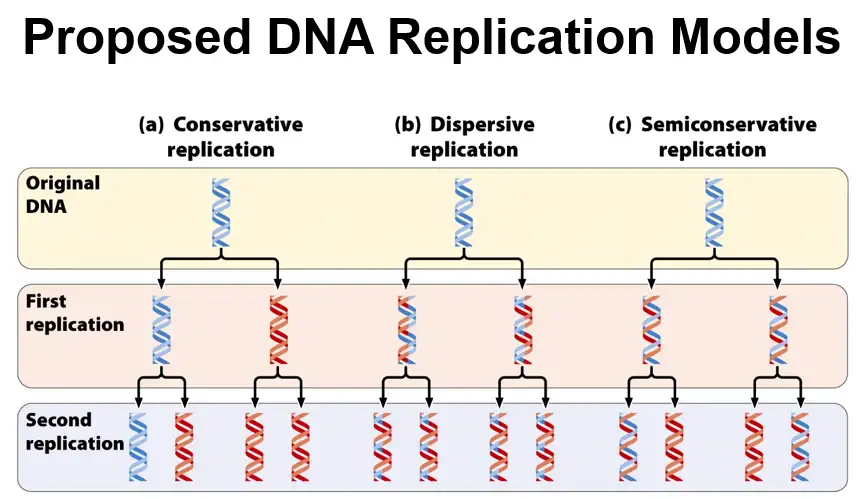
Before discussing the methods and experiments used by scientists to demonstrate semi-conservative genome replication, let’s introduce the proposed models of DNA replication.
- Conservative replication model
- Dispersive replication model
- Semiconservative replication
Studies by Watson and Crick in 1953
In their groundbreaking 1953 publication, Watson and Crick explained DNA replication as a semi-conservative process. They proposed that unwinding the DNA double helix acts as a template for synthesizing new complementary strands.
For example, in a double-stranded DNA molecule, the adenine-thymine (AT) base pair separates, with one strand containing adenine and the other containing thymine. Complementary base pairing allows thymine to pair with adenine, reestablishing the AT base pair. This process also occurs for the unwound thymine, where a new adenine nucleotide is added, forming a new AT base pair. Thus, one AT base pair in a circular DNA molecule generates two AT base pairs in two daughter DNA molecules. This replication occurs at all base pair sites.
It’s important to note that while the original double-stranded DNA structure isn’t fully preserved, each daughter DNA molecule contains one intact template strand from the parent molecule. Each daughter molecule consists of one intact template strand and one newly synthesized complementary strand. This is one of the possible replication mechanisms. Alternative models include conservative replication (where one parent DNA molecule serves as a template for another) and dispersive replication (where segments of parental DNA are preserved and combined with newly synthesized segments).
The Meselson And Stahl’s Experiment
In 1958, scientists Meselson and Stahl presented their experimental findings on the replication pattern of DNA. The researchers used Escherichia coli bacteria and cultivated them in a growth medium containing a heavy nitrogen isotope called N15, along with the natural nitrogen isotope N14. The bacterial genome became denser through multiple replication cycles in the heavy isotope environment compared to bacteria cultured in a different medium.
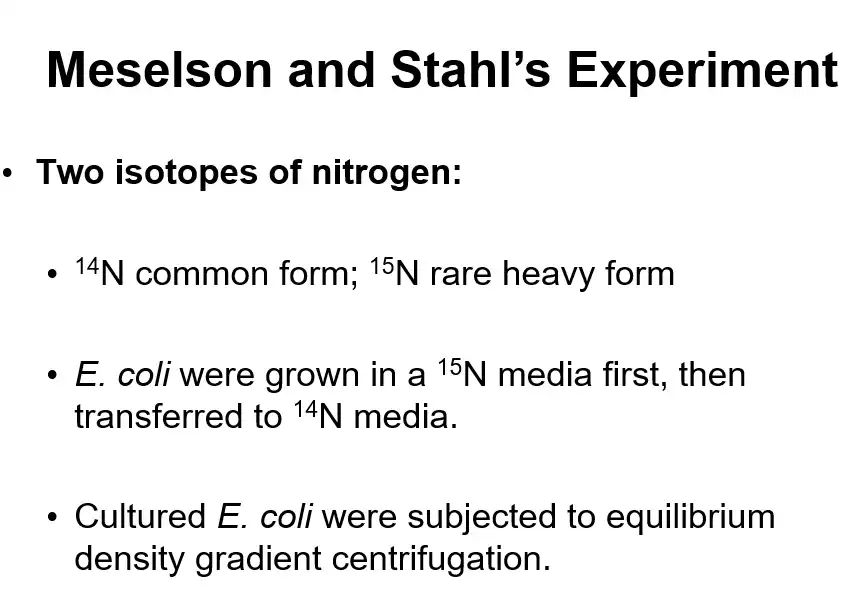
Meselson and Stahl used density gradient centrifugation, a centrifugation technique, to determine the density of bacterial DNA molecules. The cesium chloride (CsCl) solution was centrifuged in an ultracentrifuge for several hours. By creating a density gradient in the centrifuge tube, with increasing CsCl concentration from top to bottom, the DNA molecules moved to the area where their density matched.
When DNA molecules or any other molecules were introduced to a tube and centrifuged, the DNA molecules moved to the region of the tube that matched their density. If DNA molecules with different densities are added, each molecule will migrate to a region proportional to its density, resulting in the formation of distinct bands. These bands were visible under ultraviolet light because nucleic acid molecules strongly absorb light at a wavelength of 260 nanometers.
Meselson and Stahl transferred the bacteria with heavy DNA to a growth medium with light nitrogen (N14) and allowed them to replicate only once. The bacterial genomes were then centrifuged again and placed between the bands representing heavy (N15) DNA and light (N14) DNA.
If conservative replication had occurred, two distinct bands (one band for heavy DNA and one band for light DNA) would have been observed after centrifugation. However, neither of these bands formed, thus confirming the pattern of semiconservative replication.

In the case of dispersive replication, different bands were expected based on the level of dispersion within each DNA molecule. The results from the experiment on semiconservative replication aligned perfectly with the findings from the semi-conservative replication experiment.
| Experiment Details | Results and Conclusion |
|---|---|
| Researchers: | Matthew Meselson and Franklin W. Stahl |
| Objective: | To determine the mode of DNA replication |
| Experimental Organism: | Escherichia coli (E. coli) bacteria |
| Isotope Labeling: | Used heavy nitrogen isotope (15N) to label DNA |
| Experimental Design: | E. coli bacteria grown in 15N medium for many generations, then transferred to 14N medium for one or more generations |
| DNA Analysis Method: | Density gradient centrifugation using cesium chloride (CsCl) gradient |
| Expected Results: | Conservative replication – 15N-14N hybrid DNA molecules; Semiconservative replication – 15N-14N intermediate DNA molecules; Dispersive replication – 15N-14N-14N hybrid DNA molecules |
| Actual Results: | After one generation in a 14N medium, DNA was found to have an intermediate density, indicating semiconservative replication |
| Conclusion: | DNA replication is semiconservative, where each new DNA molecule consists of one parental strand and one newly synthesized strand |
Photographing DNA Replication
In 1963, Meselson and Stahl’s experiment provided further evidence for the process of DNA replication through the use of radioactive labeling and photographic techniques. The researchers aimed to investigate the mode of DNA replication and used autoradiography or radioisotopes to capture the replication process.
To begin, E. coli bacteria were cultured in a medium containing radioactive thymine, which caused the radioactive isotope to be incorporated into the thymine nucleotides of the DNA molecule.
The DNA molecules were isolated and placed on photographic film for a specific duration. The presence of radioactive materials near the film caused it to darken, enabling the estimation of the radioactive content.
The experiment yielded several important findings. Firstly, it revealed that the DNA molecule in E. coli cells has a circular structure. Secondly, it showed that the circular DNA molecule maintains its integrity without any visible breaks during replication, exhibiting an intermediate “beta” structure. Thirdly, the experiment provided support for the hypothesis of semiconservative replication, indicating that DNA replication most likely takes place within one or two “Y-shaped” structures. This suggests that the circular DNA molecule unwinds at a specific point and replication occurs in one or two directions.
Conclusion
The studies conducted by Watson and Crick in 1953 concluded that DNA replication is a semi-conservative process. This means that each daughter DNA molecule contains one intact template strand from the parent molecule. Meselson and Stahl’s 1958 experiment, which utilized density gradient centrifugation, confirmed the semiconservative replication pattern of DNA. Subsequent investigations, including autoradiography, further supported the semiconservative replication model and provided insights into the circular structure of prokaryotic DNA during replication. These findings have significantly enhanced our understanding of DNA replication mechanisms.
